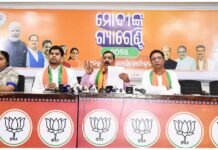By Our Correspondent
NEW DELHI/JODA/KOIRA/BHUBANESWAR: The Supreme Court bench of Chief Justice of India S.A. Bobde and Justices B.R. Gavai and Surya Kant have directed the Centre to ensure that Mining Leaseholders undertake re-grassing of the mined and other areas affected by their operations by devising appropriate methods within three weeks, sources said on Friday.
The Bench noted with concern that mining results in the complete elimination of grass in the area which results in denial of fodder to herbivores. As re-grassing technology exists, the bench saw no reason why the area which had been mined should not be restored so that grass and other vegetation including trees could grow in the mining area for the benefit of animals.
“We are of the view that this can be achieved by directing the Union of India to impose a condition in the mining lease and a similar condition in the environmental clearance and the mining plan to the effect that mining leaseholders shall, after ceasing mining operations, undertake re-grassing of the mining area and any other area which may have been disturbed due to their mining activities and restore the land to a condition which is fit for growth of fodder, flora, fauna etc.
“The Union of India may devise appropriate methods for ensuring compliance of this condition after the mining activity is over at the cost of the mining leaseholders. This condition shall be in addition to those conditions which have already been imposed for achieving the same purpose under the mine closure plan. This condition shall not be imposed in derogation of any conditions which are already in force”, the bench held in its order.
The bench issued the order in the case of Common Cause v Union of India. The NGO, Common Cause, filed a public interest petition in 2014 before the Supreme Court, seeking a detailed enquiry into illegal mining in Odisha and termination of the leases of the mining companies involved in the scam. The petition also stressed the need for a macro-environmental impact assessment.
In 2017, while hearing this case, the Supreme Court refused to accept the narrow interpretation of “illegal mining” given by lawyers representing the mining companies. The court held that illegal mining took within its fold excess extraction of a mineral over the permissible limit even within the mining lease area held under lawful authority, if that excess extraction was contrary to the mining scheme, the mining plan, the mining lease or a statutory requirement.
The court had also held that the concept of an ex post facto or a retrospective environmental clearance (EC) to a mining project was completely alien to environmental jurisprudence. The court had directed that mining companies and leaseholders, if engaged in illegal mining, would have to pay compensation equivalent to 100% value of the illegally extracted minerals. The court observed:
“It simply does not stand to reason why the state should be compelled to forego what is its due from the exploitation of a natural resource and on the contrary be a party in filling the coffers of defaulting lessees in an ill-gotten manner.”
Wednesday’s order on re-grassing of areas affected by mining takes the Supreme Court’s 2017 judgment to its logical culmination and is consistent with the the ‘Polluter Pays’ principle.
Mukul Rohatgi, senior counsel appearing for a mining lease holder told the bench comprising Justices Bobde and Deepak Gupta on January 16 last year that the mine owners would be willing to bear the cost of re-grassing upon termination of mining activities in the area since it is in the larger interest of the environment.
Rakesh Dwivedi, appearing for Odisha, was requested by the court to look into the matter and make appropriate suggestions for implementing this proposal of re-grassing after termination of mining activities. Ashok Kumar Panda, appearing for the Union of India, stated that this would be included as a part of the National Mining Policy 2019.
Despite the senior counsels’ readiness to comply with the proposal to ensure environmental remediation, the NMP 2019, released in March last year, does not go beyond paying lip service to the idea, and has nothing to suggest how it could be implemented.
“Prevention and mitigation of adverse environmental effects due to mining in accordance with the latest scientific norms and modern afforestation practices shall form integral part of mine development strategy in every instance. The guiding principle shall be that a miner shall leave the mining area in an ecological shape which is as good as it was before the commencement of mining or better with least impact on flora and fauna of the area.”
NMP 2019, which replaced NMP 2008, was a result of the Supreme Court’s direction in 2017 in the Common Cause case on rapacious mining in Odisha’s top mining districts, Keonjhar and Sundargarh. However, concerns have been expressed over NMP 2019’s effectiveness to ensure environmental protection, ecological conservation and protection of people’s rights in the mining areas. Experts have criticised NMP 2019 as being guided by the penchant for ‘ease of doing businesses’ and attracting investments. With NMP 2019 seeking to augment mineral output by 200% in seven years, both the government and the industry are likely to view the CJI bench’s latest judgment as an irritant.
The effectiveness of the Supreme Court’s intervention in the matter will be watched with interest, as a court-appointed committee of two former judges of the Supreme Court – Justices G.S. Singhvi and Anil R. Dave – had, after investigating ‘de novo’ 15 lessees accused of either having transferred control or holding mining rights in excess of permissible limits, recently cleared some of the biggest iron ore miners in Odisha of charges of illegal mining. Apex Court’s order assumes urgency as most of the mining leases in question are set to lapse on March 31 this year, and are being put to auction, according to media reports.






















